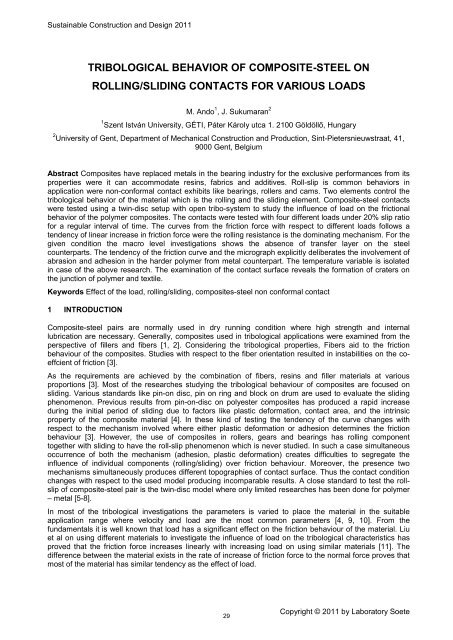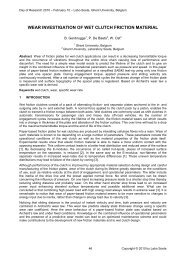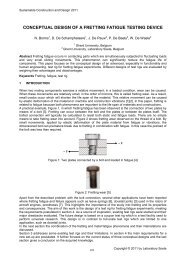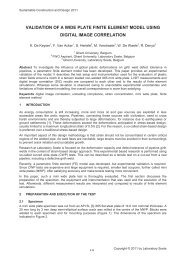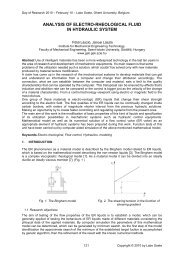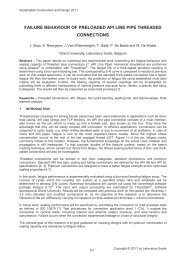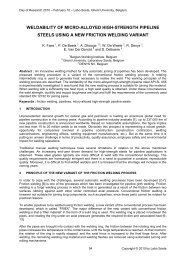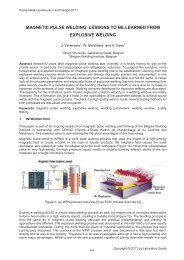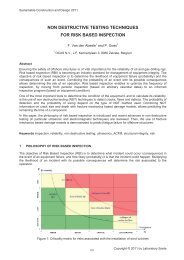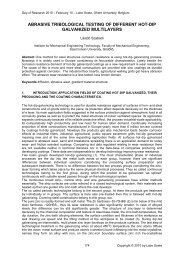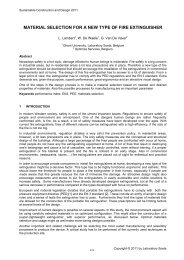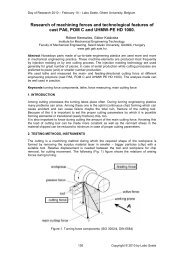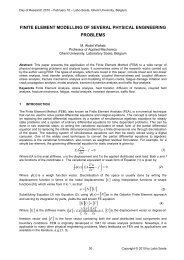Volume 2, Issue 1, 2011, Full Text - 5th International Conference on ...
Volume 2, Issue 1, 2011, Full Text - 5th International Conference on ...
Volume 2, Issue 1, 2011, Full Text - 5th International Conference on ...
Create successful ePaper yourself
Turn your PDF publications into a flip-book with our unique Google optimized e-Paper software.
Sustainable C<strong>on</strong>structi<strong>on</strong> and Design <str<strong>on</strong>g>2011</str<strong>on</strong>g><br />
TRIBOLOGICAL BEHAVIOR OF COMPOSITE-STEEL ON<br />
ROLLING/SLIDING CONTACTS FOR VARIOUS LOADS<br />
M. Ando 1 , J. Sukumaran 2<br />
1 Szent István University, GÉTI, Páter Károly utca 1. 2100 Göldöllő, Hungary<br />
2 University of Gent, Department of Mechanical C<strong>on</strong>structi<strong>on</strong> and Producti<strong>on</strong>, Sint-Pietersnieuwstraat, 41,<br />
9000 Gent, Belgium<br />
Abstract Composites have replaced metals in the bearing industry for the exclusive performances from its<br />
properties were it can accommodate resins, fabrics and additives. Roll-slip is comm<strong>on</strong> behaviors in<br />
applicati<strong>on</strong> were n<strong>on</strong>-c<strong>on</strong>formal c<strong>on</strong>tact exhibits like bearings, rollers and cams. Two elements c<strong>on</strong>trol the<br />
tribological behavior of the material which is the rolling and the sliding element. Composite-steel c<strong>on</strong>tacts<br />
were tested using a twin-disc setup with open tribo-system to study the influence of load <strong>on</strong> the fricti<strong>on</strong>al<br />
behavior of the polymer composites. The c<strong>on</strong>tacts were tested with four different loads under 20% slip ratio<br />
for a regular interval of time. The curves from the fricti<strong>on</strong> force with respect to different loads follows a<br />
tendency of linear increase in fricti<strong>on</strong> force were the rolling resistance is the dominating mechanism. For the<br />
given c<strong>on</strong>diti<strong>on</strong> the macro level investigati<strong>on</strong>s shows the absence of transfer layer <strong>on</strong> the steel<br />
counterparts. The tendency of the fricti<strong>on</strong> curve and the micrograph explicitly deliberates the involvement of<br />
abrasi<strong>on</strong> and adhesi<strong>on</strong> in the harder polymer from metal counterpart. The temperature variable is isolated<br />
in case of the above research. The examinati<strong>on</strong> of the c<strong>on</strong>tact surface reveals the formati<strong>on</strong> of craters <strong>on</strong><br />
the juncti<strong>on</strong> of polymer and textile.<br />
Keywords Effect of the load, rolling/sliding, composites-steel n<strong>on</strong> c<strong>on</strong>formal c<strong>on</strong>tact<br />
1 INTRODUCTION<br />
Composite-steel pairs are normally used in dry running c<strong>on</strong>diti<strong>on</strong> where high strength and internal<br />
lubricati<strong>on</strong> are necessary. Generally, composites used in tribological applicati<strong>on</strong>s were examined from the<br />
perspective of fillers and fibers [1, 2]. C<strong>on</strong>sidering the tribological properties, Fibers aid to the fricti<strong>on</strong><br />
behaviour of the composites. Studies with respect to the fiber orientati<strong>on</strong> resulted in instabilities <strong>on</strong> the coeffcient<br />
of fricti<strong>on</strong> [3].<br />
As the requirements are achieved by the combinati<strong>on</strong> of fibers, resins and filler materials at various<br />
proporti<strong>on</strong>s [3]. Most of the researches studying the tribological behaviour of composites are focused <strong>on</strong><br />
sliding. Various standards like pin-<strong>on</strong> disc, pin <strong>on</strong> ring and block <strong>on</strong> drum are used to evaluate the sliding<br />
phenomen<strong>on</strong>. Previous results from pin-<strong>on</strong>-disc <strong>on</strong> polyester composites has produced a rapid increase<br />
during the initial period of sliding due to factors like plastic deformati<strong>on</strong>, c<strong>on</strong>tact area, and the intrinsic<br />
property of the composite material [4]. In these kind of testing the tendency of the curve changes with<br />
respect to the mechanism involved where either plastic deformati<strong>on</strong> or adhesi<strong>on</strong> determines the fricti<strong>on</strong><br />
behaviour [3]. However, the use of composites in rollers, gears and bearings has rolling comp<strong>on</strong>ent<br />
together with sliding to have the roll-slip phenomen<strong>on</strong> which is never studied. In such a case simultaneous<br />
occurrence of both the mechanism (adhesi<strong>on</strong>, plastic deformati<strong>on</strong>) creates difficulties to segregate the<br />
influence of individual comp<strong>on</strong>ents (rolling/sliding) over fricti<strong>on</strong> behaviour. Moreover, the presence two<br />
mechanisms simultaneously produces different topographies of c<strong>on</strong>tact surface. Thus the c<strong>on</strong>tact c<strong>on</strong>diti<strong>on</strong><br />
changes with respect to the used model producing incomparable results. A close standard to test the rollslip<br />
of composite-steel pair is the twin-disc model where <strong>on</strong>ly limited researches has been d<strong>on</strong>e for polymer<br />
– metal [5-8].<br />
In most of the tribological investigati<strong>on</strong>s the parameters is varied to place the material in the suitable<br />
applicati<strong>on</strong> range where velocity and load are the most comm<strong>on</strong> parameters [4, 9, 10]. From the<br />
fundamentals it is well known that load has a significant effect <strong>on</strong> the fricti<strong>on</strong> behaviour of the material. Liu<br />
et al <strong>on</strong> using different materials to investigate the influence of load <strong>on</strong> the tribological characteristics has<br />
proved that the fricti<strong>on</strong> force increases linearly with increasing load <strong>on</strong> using similar materials [11]. The<br />
difference between the material exists in the rate of increase of fricti<strong>on</strong> force to the normal force proves that<br />
most of the material has similar tendency as the effect of load.<br />
29<br />
Copyright © <str<strong>on</strong>g>2011</str<strong>on</strong>g> by Laboratory Soete


